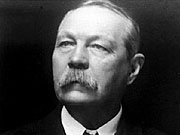Richard Lancelyn Green
From Plastic Tub
| Revision as of 22:00, 9 May 2005 Adkins (Talk | contribs) garf ← Go to previous diff |
Revision as of 22:02, 9 May 2005 Adkins (Talk | contribs) sp Go to next diff → |
||
| Line 9: | Line 9: | ||
| After a flamboyant life, Green was found garroted in his bed; the cord had been tightened with a wooden [[Crossed Spoons Device|spoon]]. Green had become increasingly paranoid in his last days, and had claimed he was being followed by a mysterious American. Although his death was later ruled a suicide, suspicions remain. | After a flamboyant life, Green was found garroted in his bed; the cord had been tightened with a wooden [[Crossed Spoons Device|spoon]]. Green had become increasingly paranoid in his last days, and had claimed he was being followed by a mysterious American. Although his death was later ruled a suicide, suspicions remain. | ||
| - | Long-time correspondent [[Mazzistow Carrington]], who as many recall wrote numerous detective novels of his own, has publicly expressed his doubts over the suicide story. In ''Grignotes 32'' (2005)--a journal normally dedicated to [[Paolo Gringnotti]]--he writes: | + | Long-time correspondent [[Mazzistow Carrington]], who as many recall wrote numerous detective novels of his own, has publicly expressed his doubts over the suicide story. In ''Grignotes 32'' (2005)--a journal normally dedicated to [[Paolo Grignotti]]--he writes: |
| :''Green's death has a certain [[Gnomic]] quality about it, the stench of which cannot be denied. Anyone with a nose for crime could tell you in an instant. This [[Counterfeiting Gang|counterfeit]] story foisted upon the public has all the earmarks of a cover-up. Green expressed certain sentiments to me that in no way intimated a desire to die. I knew the man. He was a fighter. I used certain contacts to verify details he had about that "mysterious American." He was real.'' | :''Green's death has a certain [[Gnomic]] quality about it, the stench of which cannot be denied. Anyone with a nose for crime could tell you in an instant. This [[Counterfeiting Gang|counterfeit]] story foisted upon the public has all the earmarks of a cover-up. Green expressed certain sentiments to me that in no way intimated a desire to die. I knew the man. He was a fighter. I used certain contacts to verify details he had about that "mysterious American." He was real.'' | ||
Revision as of 22:02, 9 May 2005
|
Born 10 July 1953 Died 27 March 2004. Although reknowned for his popular renditions of Homeric and Arthurian legends, it is for his work with Sherlock Holmes that Green is most noted. After a flamboyant life, Green was found garroted in his bed; the cord had been tightened with a wooden spoon. Green had become increasingly paranoid in his last days, and had claimed he was being followed by a mysterious American. Although his death was later ruled a suicide, suspicions remain. Long-time correspondent Mazzistow Carrington, who as many recall wrote numerous detective novels of his own, has publicly expressed his doubts over the suicide story. In Grignotes 32 (2005)--a journal normally dedicated to Paolo Grignotti--he writes:
Carrington happened to come into contact with Gringotes during the course of research which he believed the violin Holmes plays in the celebrated stories was once the famous Italian master's. Less sentimental analysts have declared that Carrington is incorrect. They do not doubt the reality of a mysterious American, but do believe the suicide was genuine. "It was the ultimate act of sacrifice to draw attention to some dark force gathering on the horizon," writes Winthrop Dunn in the popular Holmsiana magazine." A third interpretation has it that Green in fact had an extreme form of body image dysfunction which led him to amputate his entire body -- by killing himself. The spoon, they say, indicates his desire to shed this fat mortal coil, weighted down with eating and its accompanying farts; the spoon is the ultimate sybol of the body need which shackles the spirit. In an extreme form of Gnostic asceticism, Green made that ultimate transition. Plastic Tub sees an attractive merit in this last position, but ultimately believes one of the first two possibilities is likely. All evidence, to be presented as sson as it is properly compiled will be herein presented. What is certain is that there was a mysterious American by the name of Stanley Adcock who flew to England and stayed near Green's death apartment. He is known to have made several telephone calles to known Gnomes. Soon after Green's death Adcock returned to the States and thereafter retired to a life of relative seclusion in Coeur d'Alene, Idaho. See Also |
DesiderataGreen also collected plaid pants; his collection numbered in the high hundreds. |

